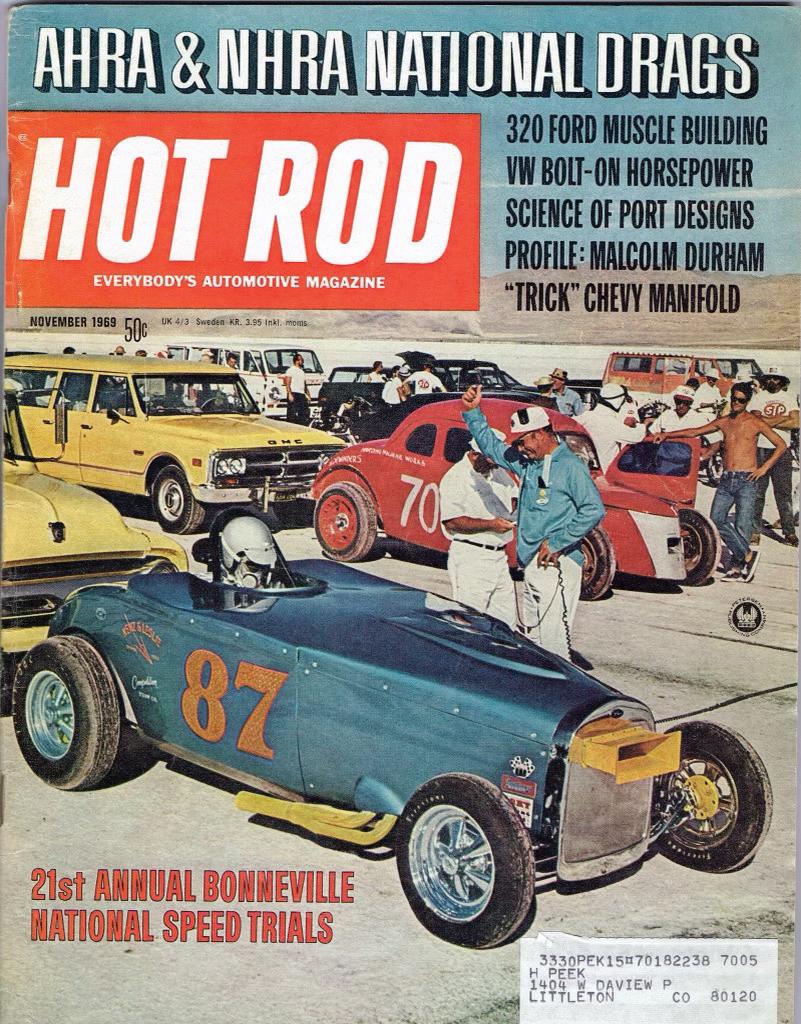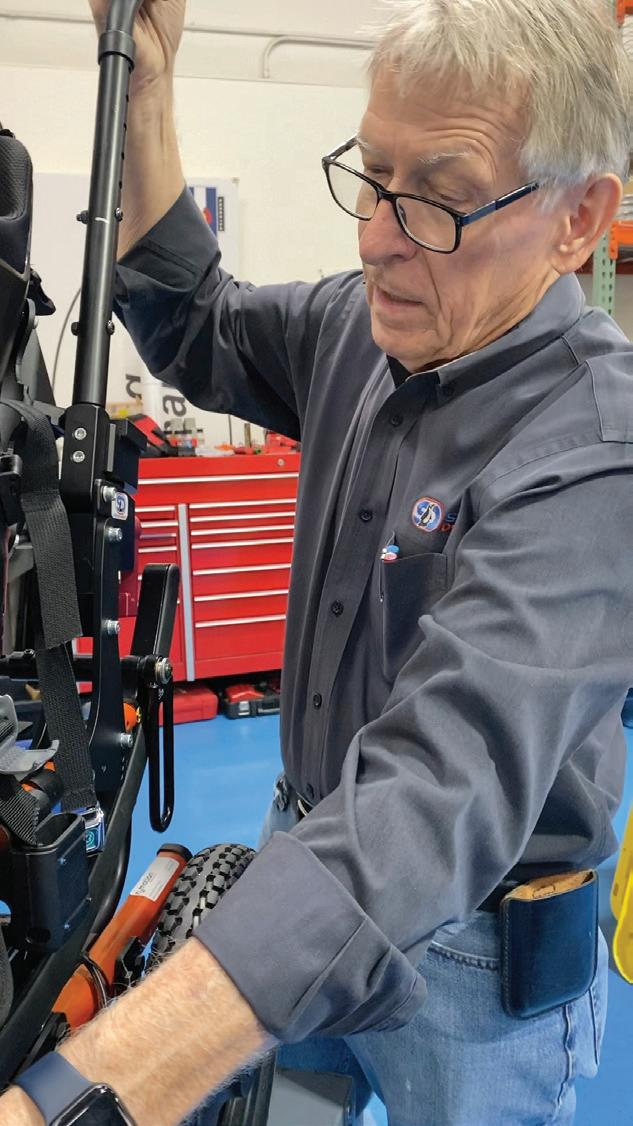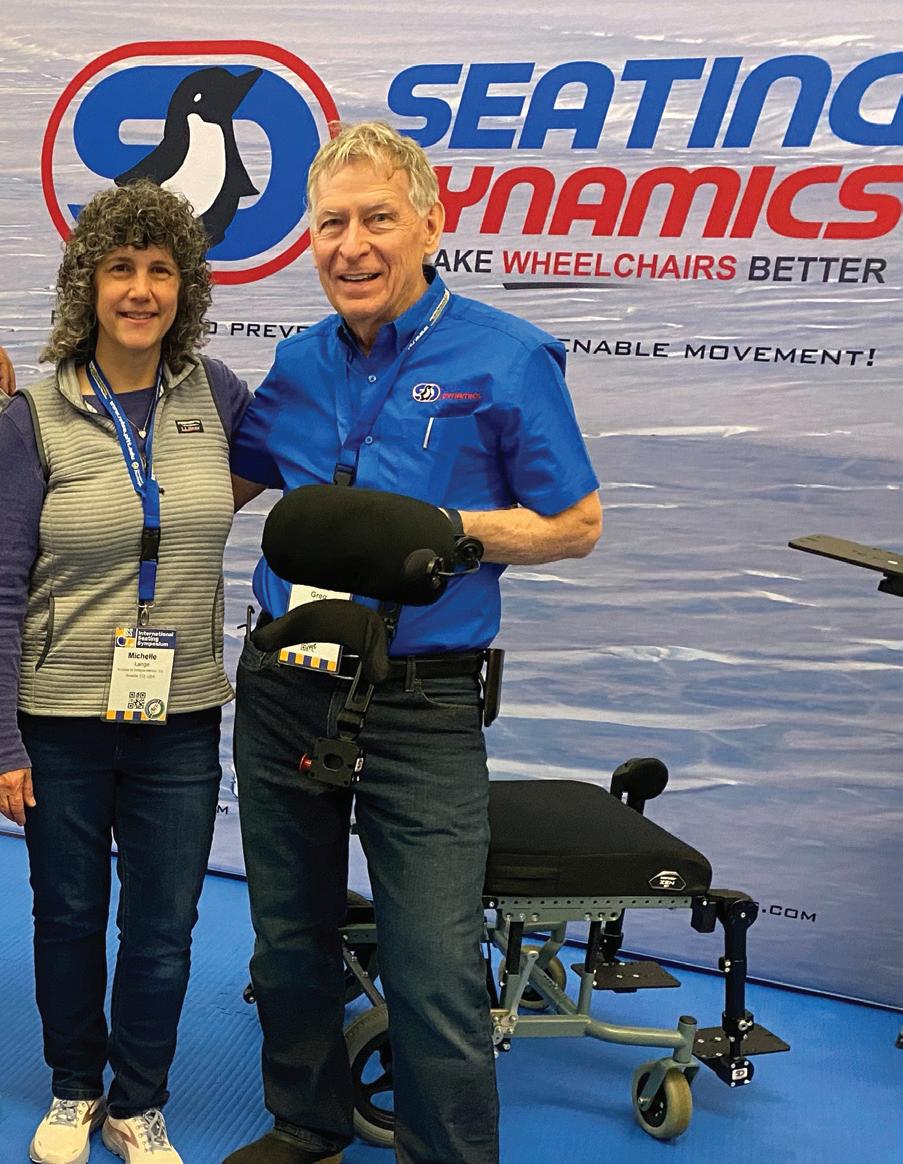
9 minute read
GREG PEEK HAS BUILT LONG TRACK RECORD OF SUCCESS INSIDE, OUTSIDE COMPLEX REHAB INDUSTRY
Written by: DOUG HENSLEY
For Greg Peek, there has been nothing typical about the trajectory of his career. The only direction has been up, and the only way has been forward.
For the most part, he has been in perpetual motion throughout, making an impact and leaving a legacy all along the way.
Peek is president of Seating Dynamics, in Centennial, Colorado. But that’s only the latest chapter in a life devoted to working hard and making a difference as he has now spent 44 years in the wheelchair field as a manufacturing business owner.
“I never could have guessed I would be in this role today,” he said. “I had no idea where I was going during my early years, and things kind of evolved around a passion for race. The wheelchair field was just a pure accident, but after you fall in, you can’t get out.”
Before wheelchairs and becoming a self-employed business owner more than 50 years ago, Peek had two other jobs. The first was as a tool and die apprentice; the second was setting up and running a mechanical test lab for a company building pneumatic transit tube systems.
“Breaking things and figuring out why they broke was an absolute blast,” he said.

BREAKING THINGS AND FIGURING OUT WHY THEY BROKE WAS AN ABSOLUTE BLAST
“I think you must be passionate about something. In my early years, I was beyond passionate about race cars. I was probably obsessed with building the most advanced and nicest race car of its type. That first car has that reputation to this day.
“I never could have dreamed I would wind up in the wheelchair field, much less stay here. But here I was with the capability of answering questions and solving problems, which is what I enjoy doing more than anything else.”

And there have been a lot of career highlights along the way. Remember his love of racing? He built his first race car between his junior and senior years of high school with an updated version of the car eventually being a dedicated cover car of Hot Rod magazine just three years later.
The first exposure to wheelchairs came in 1976, landing a contract with the local regional transportation district to produce 50 sets of wheelchair restraint devices which they had licensed. Then came participating in the design, of, and building the original seat prototypes for the space shuttle; producing replacement parts for military aircraft; and designing technical rock-climbing hardware.
Always searching for business opportunities, Peek met Dick Devoe, the owner of the primary supplier to Craig Hospital and one of the few stores in the country dealing in “high-quad power wheelchairs” while fulfilling the transportation district’s restraint contract.
That meeting paid off in the spring of ’81 in an annual check-in phone call with Devoe, who said, “Come over to the store. I have something to show you.”
That something turned out to be a need for a better power recliner add-on, which “raised the back post pivot point to match a high profile Roho cushion and kept the actuator from rubbing on the sling seat upholstery.”

Thirty days later the first modern and successful low shear power recline kit was delivered. Building the wheelchair restraint system for that bus company is ultimately what pulled Peek into the wheelchair business. He and his brother Michael started LaBac Systems in the early 1980s before selling the company in 1997.
“I love having the opportunity to have a positive impact on people’s lives,” Peek said. “I have worked in different fields, but I have always tried to think outside the box. The one element that has remained constant through everything I’ve done involves tubing and wheels, like race cars, bikes and wheelchairs.”
Peek has had several professional successes in the years since, some in wheelchair design and some in the race car world. Those are:
February 1983, moving beyond the low-shear recliner developed in 1981, Peek identified a need for a better recliner to eliminate shear in the back, not just reduce it. Design work started but was put on hold when life got in the way.
August 1983, LaBac Systems incorporated in Colorado.
November 1984, Peek first attended the National Home Health Care Exhibition in Atlanta, Georgia.
1985, Peek Exhibited at the first International Seating Symposium in Memphis, Tennessee. The bolt-on recliner kit became the drop-on recliner when a solid welded seat frame assembly converted the folding, belt drive, 24-inch rear wheel into a rigid frame chair, opening new possibilities.
1985-1986, Life got out of the way and the “Sliding Back” recliner is completed, patent applied for. The first power recliner successfully addressed shear elimination.

1986-1987, Introduction of the first “Power Base,” the Fortress FS-655, pushed the “Drop-On” recliner into a complete and comprehensive power recline seating system, from the footrest to the headrest and everything in between, all from LaBac Systems.
1988, LaBac Systems pushes the envelope requiring education and training in the Highlands Ranch, Colorado, training facility at the factory. It is believed that this was the first time a company required training to purchase products.
1990-1991, Designed and produced the LaBac MTC, the first adult-size manual tilt chair. This was followed by several alphabet soup variations. Designed and patented “Active Anti-Tippers” for use on short wheelbase power chairs, essentially creating a six-wheeled chair, which prevented tipping. Additionally, several custom seat elevating seats/carts for power chairs utilizing scissor lifts, predating what everyone does today.
1996, Designed and patented the Variably Adjustable Lower Body Support, also known as 4 Axis footrest, and modular adjustable seat frame for wheelchairs, a width and depth adjustable solid seat frame, which could also have functional components added or deleted to change the configuration and function of the power seat — essentially what everyone does today.

June 1997, This was a year that everyone experiences in some way, “the biggest mistake of my life” when LaBac is sold to Graham Field. The legal handcuffs and bankruptcy protection forced Peek out of the industry and held him out until April 2003.
Summer 2003, Peek moves back into the LaBac building and starts preparation for reentry into the wheelchair field, attending Medtrade later that year introducing a new line of "Degage" manual tilt wheelchairs. Probably the most robust and durable adult manual tilt chair ever made, just a little bit ugly.
2005, While exhibiting at ISS in Orlando a therapist asks, “Can you do anything to stop these “Rocker Bangers” from breaking the back canes from their chairs.” Peek, still not knowing there are things he can’t do, says yes.
Late 2005, The “Dynamic Rocker Back” is born, Seating Dynamics follows shortly thereafter, and the rest is recent history. Seating Dynamics has become and is still the only company worldwide to focus exclusively on dynamic seating components for wheelchairs.
August 2018, Designs and builds wheels enabling the "Turbinator streamliner" to become the world’s fastest and only wheel-driven vehicle to traverse the Bonneville Salt Flats at over 500 mph.
August 2021, Designs and builds the motor drive systems allowing the “Vesco Little Giant” to become the world’s fastest electric vehicle at over 357 mph.
Peek’s life has also been filled with a lot of highlights and memorable moments. The challenge comes in trying to select only a few.
“We had an incident here a few months ago with a local kid,” he said. “I don’t know all the diagnoses, but there was a 9-year-old, 37-pound boy with a beautiful little orange Zippie Iris full of our dynamic components and an Aspen ASO. The supplier did a beautiful job of assembling the chair; it was good looking, but it didn’t work.
“The chair was not working because everyone involved didn’t see the big picture. It did not fit him, and the geometry between the DRBi and the ASO was a mess. I wasn’t afraid to jump in and get my hands dirty and my feet wet. We modified the chair itself from front to back and made different pieces. When done, it fit, and he was able to move the dynamic components, now including the ASO for the first time.”
Another local mother sent comments to the Centers for Medicare and Medicaid Services in response to the recent funding reduction, she said, “Dynamic seating has changed my son’s life and probably extended his life.”
Peek said, “I am fortunate to have the opportunity to have an impact on lives like I have; most people don’t get that chance.”
Peek has seen a lot of industry challenges through the years.
“Navigating the government-imposed funding on the complex rehab industry as a whole is one of the biggest challenges,” he said. “As an industry, we seem to be helpless in trying to educate and communicate to bureaucrats who don’t listen. They act on some preconceived notion, which only protects their budget but puts the existence of entire product categories at risk of disappearing.
“My little dynamic seating niche is so small it has a microscopic impact on the CMS budget, yet we just saw a fee schedule amount go into effect, which was an 80% reduction from the industry average MSRP. We are concerned this is just the tip of the iceberg.”
As he looks ahead, Peek hasn’t slowed down at all. He is busy working to get a second company up and running, a metal finishing business specializing in aluminum anodizing, that he hopes is humming by the end of September. It’s not something he wanted but was pushed into it by the failure of other local companies’ inability to provide consistent high-quality hard black anodizing.
“Plus, I have things to do in this field as far as new ideas and new products I’m working on that the world hasn’t seen yet or even thought of. I’ve been fortunate to have a lot of opportunities and have done a lot of things. And it has been all sorts of fun.”
Greg may be reached at GREG@SEATINGDYNAMICS.COM


